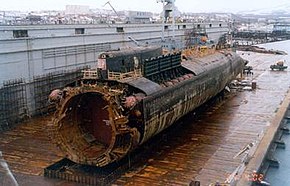 Wreck of Kursk in a floating dock at Roslyakovo | |
| Date | 12 August 2000 |
|---|---|
| Time | 11:29:34 a.m. – 11:31:48 a.m. (UTC+04:00) |
| Location | Barents Sea |
| Coordinates | 69°36′59″N 37°34′30″E / 69.61639°N 37.57500°E |
| Cause | Faulty weld on a 65-76 "Kit" practice torpedo, leading to an explosion of high-test peroxide and secondary detonation of 5 to 7 torpedo warheads |
| Outcome | Loss of the boat, crew, headquarters personnel |
| Deaths | 118 (all) |
| Convictions | None |
The Russian nuclear submarine K-141 Kursk sank in an accident on 12 August 2000 in the Barents Sea, with the loss of all 118 personnel on board. The submarine, which was of the Project 949A-class (Oscar II class), was taking part in the first major Russian naval exercise in more than 10 years. The crews of nearby ships felt an initial explosion and a second, much larger explosion, but the Russian Navy did not realise that an accident had occurred and did not initiate a search for the vessel for over six hours. The submarine's emergency rescue buoy had been intentionally disabled during an earlier mission and it took more than 16 hours to locate the submarine, which rested on the ocean floor at a depth of 108 metres (354 ft).
Over four days, the Russian Navy repeatedly failed in its attempts to attach four different diving bells and submersibles to the escape hatch of the submarine. Its response was criticised as slow and inept. Officials misled and manipulated the public and news media, and refused help from other countries' ships nearby. President Vladimir Putin initially continued his vacation at a seaside resort in Sochi[1] and authorised the Russian Navy to accept British and Norwegian assistance only after five days had passed. Two days later, British and Norwegian divers finally opened a hatch to the escape trunk in the boat's flooded ninth compartment, but found no survivors.
An official investigation concluded that when the crew loaded a dummy 65-76 "Kit" torpedo, a faulty weld in its casing leaked high-test peroxide (HTP) inside the torpedo tube, initiating a catalytic explosion.[2] The torpedo manufacturer challenged this hypothesis, insisting that its design would prevent the kind of event described. The explosion blew off both the inner and outer tube doors, ignited a fire, destroyed the bulkhead between the first and second compartments, damaged the control room in the second compartment, and incapacitated or killed the torpedo room and control-room crew. Two minutes and fifteen seconds after the first explosion, another five to seven torpedo warheads exploded. They tore a large hole in the hull, collapsed bulkheads between the first three compartments and all the decks, destroyed compartment four, and killed everyone still alive forward of the sixth compartment. The nuclear reactors shut down safely. Analysts concluded that 23 sailors took refuge in the small ninth compartment and survived for more than six hours. When oxygen ran low, they attempted to replace a potassium superoxide chemical oxygen cartridge, but it fell into the oily seawater and exploded on contact. The resulting fire killed several crew members and triggered a flash fire that consumed the remaining oxygen, suffocating the remaining survivors.
The Dutch company Mammoet was awarded a salvage contract in May 2001. Within a three-month period, the company and its subcontractors designed, fabricated, installed, and commissioned over 3,000 t (3,000 long tons; 3,300 short tons) of custom-made equipment. A barge was modified and loaded with the equipment, arriving in the Barents Sea in August.[3] On October 3, 2001, some 14 months after the accident, the hull was raised from the seabed floor and hauled to a dry dock.[4] The salvage team recovered all but the bow, including the remains of 115 sailors, who were later buried in Russia.[5] The government of Russia and the Russian Navy were intensely criticised over the incident and their responses. A four-page summary of a 133-volume, top-secret investigation revealed "stunning breaches of discipline, shoddy, obsolete and poorly maintained equipment", and "negligence, incompetence, and mismanagement". It concluded that the rescue operation was unjustifiably delayed and that the Russian Navy was completely unprepared to respond to the disaster.[6]
- ^ Zygar, Mikhail (2016). All the Kremlin's men : inside the court of Vladimir Putin. New York: PublicAffairs. p. 37. ISBN 978-1-61039-739-1. OCLC 949553556.
- ^ Paschoa, Claudio (3 October 2013). "Remembering the Kursk Submarine Sinking". Marine Technology News. Archived from the original on 12 August 2022. Retrieved 28 March 2022.
- ^ "SignatureCase Kursk". www.mammoet.com. Archived from the original on 25 November 2020. Retrieved 24 April 2021.
- ^ "Kursk submarine raised". www.cnn.com. 8 October 2001. Retrieved 20 June 2023.
- ^ Cite error: The named reference
recovery-paper-2003was invoked but never defined (see the help page). - ^ Cite error: The named reference
brannonwas invoked but never defined (see the help page).


